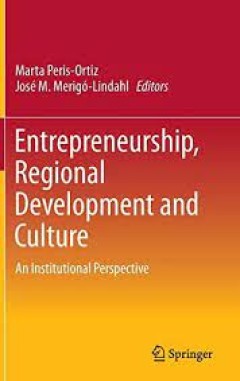Filter by

A History of Chinese Science and Technology: Volume 3
A History of Chinese Science and Technology (Voulumes 1, 2 & 3) presents 44 individual lectures, beginning with Ancient Chinese Science and Technology in the Process of Human Civilizations and An Overview of Ancient Chinese Science and Technology, and continuing with in-depth discussions of several issues in the history of science and the Needham Puzzle, interspersed with topics on Astronomy, A…
- Edition
- Ed. 1
- ISBN/ISSN
- 978-3-662-44163-3
- Collation
- -
- Series Title
- -
- Call Number
- 501 HIS h

Entrepreneurship, Regional Development and Culture An Institutional Perspective
The aim of this book is to analyze the relationships among entrepreneurship, regional development and culture in the current economy. Using an institutional approach, it examines the main theoretical issues and practices and their effect on different dimensions of society and the economy. Business creation is considered a key element of economic growth, innovation and employment. In recent year…
- Edition
- -
- ISBN/ISSN
- 978-3-319-15111-3
- Collation
- 31 b/w illustrations, 3 illustrations in colour
- Series Title
- -
- Call Number
- -

Entrepreneurship, Human Capital, and Regional Development Labor Networks, Kn…
This book makes original contributions to the literature on clusters, human capital, and regional development by focusing on the link between entrepreneurship and economic growth, aiming for a better understanding of the dynamics of growth determined by the entrepreneur’s action in the regional space. The focus is therefore on critical reflection and rethinking the articulation between three …
- Edition
- -
- ISBN/ISSN
- 978-3-319-12871-9
- Collation
- 18 b/w illustrations, 12 illustrations in colour
- Series Title
- -
- Call Number
- -

Entrepreneurship in BRICS Policy and Research to Support Entrepreneurs
This book presents selected articles that discuss important issues related to entrepreneurship in Brazil, Russia, India and China as well as contributions from authors whose countries have a tradition on entrepreneurship support, such as Italy and the UK. The articles were presented and discussed in a conference on Entrepreneurship in Brazil in November 2013 organized by the Institute of Econom…
- Edition
- -
- ISBN/ISSN
- 978-3-319-11412-5
- Collation
- 50 b/w illustrations
- Series Title
- -
- Call Number
- -

Entrepreneurs in Family Business Dynasties Stories of Italian-Australian Fam…
This book is a longitudinal story of seven Italian-Australian family business dynasties, spanning over a hundred years across three generations, and starting with the founding generation who migrated to Australia in the first half of the 20th century. With hard work and sacrifices, they set the foundations of a long-lasting family culture, and the values that form the glue of a multigenerationa…
- Edition
- -
- ISBN/ISSN
- 978-3-319-13918-0
- Collation
- 83 b/w illustrations
- Series Title
- -
- Call Number
- -

A Design for a Reusable Water-Based Spacecraft Known as the Spacecoach
Based on components already in existence, this manual details a reference design for an interplanetary spacecraft that is simple, durable, fully reusable and comprised mostly of water. Using such an accessible material leads to a spacecraft architecture that is radically simpler, safer and cheaper than conventional capsule based designs. If developed, the potential affordability of the design w…
- Edition
- Ed. 1
- ISBN/ISSN
- 978-3-319-22676-7
- Collation
- -
- Series Title
- -
- Call Number
- 629.4 MCC d

Enterprise Governance of Information Technology Achieving Alignment and Valu…
Featuring numerous case examples from companies around the world, this second edition integrates theoretical advances and empirical data with practical applications, including in-depth discussion on the COBIT 5 framework which can be used to build, measure and audit enterprise governance of IT approaches. At the forefront of the field, the authors of this volume draw from years of research and …
- Edition
- -
- ISBN/ISSN
- 978-3-319-14547-1
- Collation
- 56 b/w illustrations, 60 illustrations in colour
- Series Title
- -
- Call Number
- -

Enhancing Synergies in a Collaborative Environment
This volume contains a selection of the best papers presented at the 8th International Conference on Industrial Engineering and Industrial Management, XX International Conference on Industrial Engineering and Operations Management, and International IIE Conference 2014, hosted by ADINGOR, ABEPRO and the IIE, whose mission is to promote links between researchers and practitioners from different…
- Edition
- -
- ISBN/ISSN
- 978-3-319-14078-0
- Collation
- 71 b/w illustrations
- Series Title
- -
- Call Number
- -

Topical Themes in Energy and Resources
This book combines issues several critical ones in the energy field (low-energy technologies, renewable energies such as the hydrogen economy, and geothermal energy). Moving towards a more sustainable world requires a complete revolution in the way we manage energy and resources. However, from an academic perspective, this theme is so broad that most educators and researchers tend to focus o…
- Edition
- -
- ISBN/ISSN
- 978-4-431-55309-0
- Collation
- 45 b/w illustrations, 118 illustrations in colour
- Series Title
- -
- Call Number
- -

Tissue and Organ Regeneration in Adults
This textbook describes the basic principles of induced organ regeneration in skin and peripheral nerves and extends the original successful paradigm to other organs. A set of trans-organ rules is established and its use in regeneration of several organs is illustrated from the works of several independent investigators who worked with a variety of organs, such as the lung, the bladder, and the…
- Edition
- -
- ISBN/ISSN
- 978-1-4939-1865-2
- Collation
- 40 b/w illustrations, 21 illustrations in colour
- Series Title
- -
- Call Number
- -
 Computer Science, Information & General Works
Computer Science, Information & General Works  Philosophy & Psychology
Philosophy & Psychology  Religion
Religion  Social Sciences
Social Sciences  Language
Language  Pure Science
Pure Science  Applied Sciences
Applied Sciences  Art & Recreation
Art & Recreation  Literature
Literature  History & Geography
History & Geography